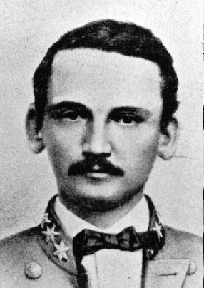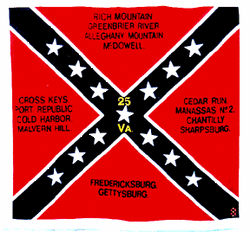War-time Service of John Carlton Higginbotham

John C. Higginbotham left Lynchburg Military Institute as an 18-year-old cadet to form a Confederate infantry company, the Upshur Grays, in April 1861 in an area of western Virginia that on June 20, 1863, became part of the new state of West Virginia.
Elected captain of the unit, Higginbotham advanced rapidly up the ladder to become Colonel of the 25th Virginia Infantry Regiment within two years. Highly respected by his men, Higginbotham was promoted to Brigadier General in May 1864 when he was only 21 years old. Ironically, the commission arrived just days after Higginbotham was shot through the heart and killed at the “Mule Shoe” during the battle of The Wilderness.
He previously had been wounded 7 times in battle.
History of Upshur Grays (Co. B, 25th Virginia Infantry Regiment)

The Upshur Grays, a Confederate infantry company raised in a predominantly Unionist county in
western Virginia (later West Virginia) were sworn into state service on May 7, 1861, and into Confederate service on May 27, 1861. Mustered in were 67 men, only four of whom were above the age of 23. Elected captain was John C. Higginbotham, an 18-year-old cadet at Lynchburg Military Institute who had left school to organize the company in April. Originally designated Company A of the 25th Virginia Infantry Regiment, the unit would become Company B in a major reorganization on May 1, 1862.
Soon after being mustered in, the Grays were sent to Philippi, about 20 miles from the Upshur County seat of Buckhannon. They arrived on June 2, 1861, just in time to take part in the first skirmish of the Civil War the following day.
The Grays went into their first action armed only with old-style smoothbore muskets with no bayonets and no cartridge boxes. They were scheduled to have their first firing practice with their muskets on June 3, but Union forces arrived before that occurred. Retreating to Beverly, some 30 miles southeast of Buckhannon, the Grays took part in a skirmish at Middle Fork bridge on the Upshur-Randolph County line on July 7, then participated in their first major action at the battle of Rich Mountain on July 11. In that battle, the Grays had their first casualties when Clay Jackson and Oscar Sherwood were killed.
The Upshur Grays fought in the battle at Greenbrier River on Oct. 3 and later dropped back a few miles to set up winter quarters on Allegheny Mountain.
Union forces attacked the 25th Virginia’s camp there on Dec. 13, but were driven back. However, the 25th lost 9 men killed, 23 wounded and 10 captured.
In the spring of 1862, the 25th Virginia came under the command of Gen. Thomas J. (Stonewall) Jackson. On May 8, the Grays found themselves directly across the field from Union forces from Upshur County at the battle of McDowell. Victorious there, the 25th Virginia then fought under Jackson in his famous “Valley Campaign” in the spring of 1862 (including victories at Cross Keys and Port Republic) before marching to Richmond to take part in the “Seven Days” battles that drove Union Gen. George B. McClellan from the environs of Richmond. The 25th Virginia was particularly prominent in the victory at Gaines’ Mill on June 27.
The 25th took part in nearly all of the major actions of the Army of Northern Virginia under Gen. Robert E. Lee through the rest of 1862 and early 1863, including 2nd Manassas/Bull Run, Sharpsburg/Antietam, and Fredericksburg. The regiment missed the battle of Chancellorsville in May of 1863, however, because it was assigned to a raid in western Virginia under Col. John D. Imboden. That was the only occasion during the war in which the Upshur Grays got
to see family and friends in Upshur County, as Imboden’s men spent April 29-May 2 in Buckhannon.
The 25th Virginia returned to the Army of Northern Virginia in late May, just as a major reorganization took place as the result of Stonewall Jackson’s fatal wound at Chancellorsville. The regiment remained in the 2nd Corps, now under command of Gen. Richard S. Ewell. In July the 25th Virginia participated in the battle of Gettysburg, seeing much action in the assaults on Culp’s Hill on July 2-3.
On Christmas Day, 1863, members of the Upshur Grays were given their first furloughs since entering service in the spring of 1861. Most took effect
on New Year’s Day, 1864, and allowed the men 60 days to spend as they wished—so long as they did not try to cross enemy lines to return to Upshur County.
In 1864, the 25th Virginia participated in The Wilderness and Spotsylvania battles, with most of the regiment taken prisoner in the disastrous defeat at
the “Mule Shoe” or “Bloody Angle” on May 12. Young John Higginbotham, who had been Colonel of the 25th Virginia for more than two years, had been shot through the heart and killed two days earlier while leading troops that halted a Federal attack within Confederate lines. A promotion to Brigadier General for the 21-year-old Colonel arrived a short time later.
In June, 1864, the remnants of the 25th Virginia (including a few Upshur Grays who had escaped capture at the “Mule Shoe”) were assigned to a new Valley Army under command of Gen. Jubal Early. They participated in the raid on Washington, D.C., in early July and later took part in the battle Oct. 19 at Cedar Creek, where an early Confederate “victory” was turned into a stunning defeat when Gen. Phil Sheridan led Union reinforcements against the Confederates.
From December, 1864, into early April, 1865, the few 25th Virginia survivors were assigned to the defenses around Richmond and Petersburg. They participated in the retreat April 2-9, and a handful took part in the official surrender ceremony at Appomattox on April 12